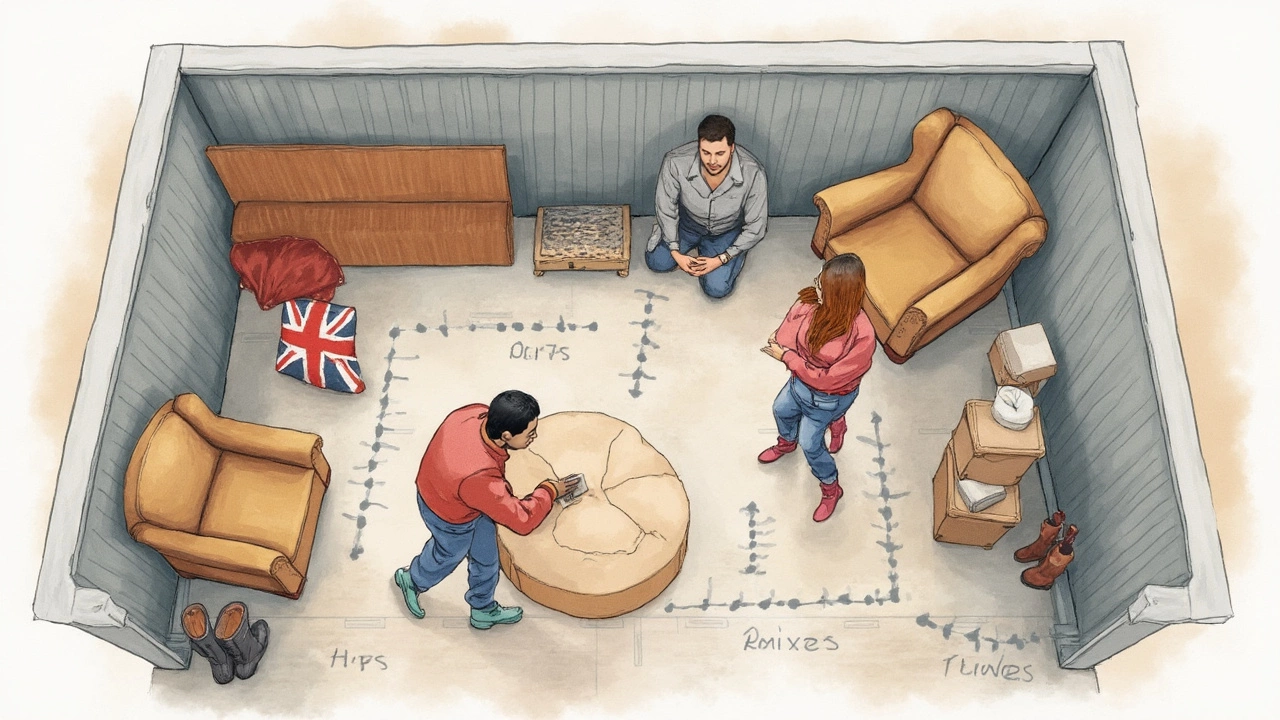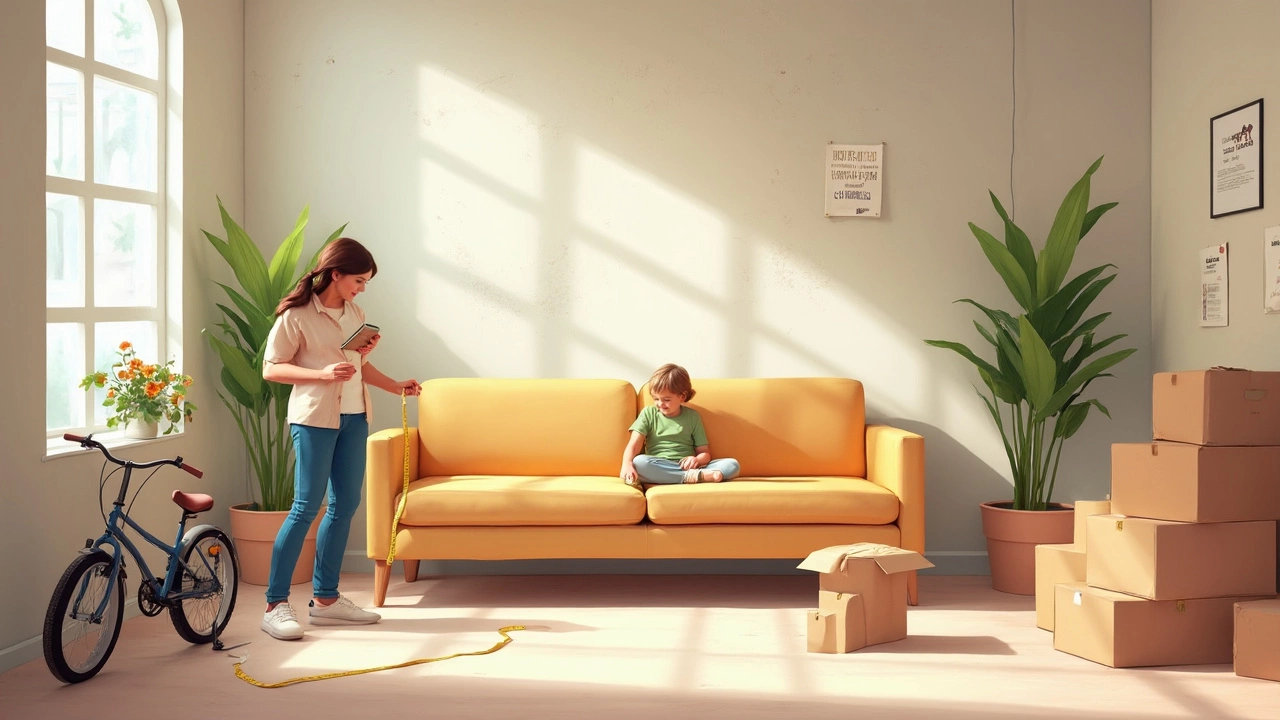Trying to figure out if your couch will fit in a 10x10 storage unit? Happens to the best of us—just last year, I found myself sweating next to a stack of furniture, tape measure in hand, while my daughter asked if we could store her oversized bean bag too. There’s good news: a 10x10 unit is way more spacious than a closet, but not quite a garage. Think about it as half the size of a tiny one-car garage. Most standard couches—even those plush three-seaters—will fit in there, along with other must-keep items.
But hold on, it’s not just about cramming things inside. Throwing everything in without a plan can end up costing you time and money. Before you start lugging that couch around, grab your measuring tape and check its length, depth, and height. Don’t just eyeball it. Couches can be deceiving—the arms or the back might be taller than a doorway, which makes a tight fit even tighter inside a storage space.
- What Can Actually Fit in a 10x10 Storage Unit?
- How to Measure and Prep Your Couch
- Smart Ways to Arrange Furniture
- Tips to Maximize Space and Avoid Headaches
What Can Actually Fit in a 10x10 Storage Unit?
A 10x10 storage unit gives you a hundred square feet of space—picture a small bedroom or about half a standard garage. You’re not squeezing your whole house in here, but there’s room for more than you might guess.
On average, people use this size to store items from a two-bedroom apartment. That usually means a couch or two, a mattress set, a couple of dressers, and a bunch of moving boxes with the kitchen gadgets you forgot you owned. Let me lay it out a little clearer:
- Couches (most regular size sofas—even a sectional if you break it up)
- Queen or full-size beds with frames, plus nightstands
- Dressers, bookshelves, or small desks
- Medium-sized appliances (think washer/dryer or compact fridge)
- Boxes—lots of boxes. I usually stack them 2-3 high along the back or sides
If you’re a numbers person, most 10x10 units are about 8 feet tall. So, if you stack items carefully, you can easily fit taller furniture or stack boxes and chairs to save floor space. Here’s a quick table with the average dimensions of common furniture you might cram inside:
| Item | Average Size (inches) |
|---|---|
| Couch | 84 x 38 x 34 |
| Queen Mattress | 60 x 80 x 12 |
| Dresser | 60 x 20 x 35 |
| Standard Box | 18 x 18 x 16 |
The real trick is knowing how to use both the floor space and the height. You can tip couches up (on their arms, wrapped in a cover) if you need more room. Just be mindful of blocking items you’ll need later—nobody wants to empty half the unit just to grab a single chair.
How to Measure and Prep Your Couch
Grabbing your tape measure is the first smart move before loading up any 10x10 storage unit. Couches come in all shapes, so you want numbers, not guesses. The average full-sized sofa runs about 84 inches long, 38 inches deep, and 34 inches high, but some sectionals and loveseats are way bigger or smaller. Write down these three numbers for your couch: length (arm to arm), depth (from the front of the seat to the furthest back point), and height (from the floor to the tallest spot).
If your cushions come off, take them off. If your legs or arms unscrew, stash those separately. This can chop off several inches and make stacking easier in a 10x10 storage unit. For big sectionals, break them down as far as they’ll go. Most moving pros recommend wrapping the couch in moving blankets or old sheets—plastic wrap can trap moisture and cause mold, especially if you’re stashing it for months.
- Use stretch wrap ONLY if the unit is climate controlled; otherwise stick to blankets.
- Vacuum under cushions and wipe down surfaces before storing to keep out bugs and dust.
- Bag up screws or legs in a zip-lock and tape it to the frame so you don’t lose anything.
- Label each piece with painter’s tape if your couch has several parts.
Here’s a quick look at standard couch sizes to help you compare:
| Type | Average Length (inches) | Average Depth (inches) | Average Height (inches) |
|---|---|---|---|
| Loveseat | 63 | 38 | 34 |
| Standard Sofa | 84 | 38 | 34 |
| Sectional (per piece) | 60-100 | 38 | 34 |
We’ve all seen those folks wrestling a stuffed couch through a narrow storage door. Save yourself the stress: measure both the furniture and the storage unit’s doorway before showing up with a truckload.

Smart Ways to Arrange Furniture
Packing a 10x10 storage unit takes a bit of planning, especially if you want to squeeze in a couch without making a giant game of Tetris out of your life. The key is to maximize every inch and make sure your stuff comes out looking the same as it went in.
The golden rule? Store your couch and large furniture first, since they’re the hardest to move around later. If your couch has removable legs or cushions, take them off and wrap them up. Tilt the couch up on its side or stand it on its end if possible—most standard units have at least an 8-foot ceiling, so you get more floor space this way. Just double check your couch height before you try this trick, so you don’t wedge it in like a cork in a bottle.
If you need to store more than just one big item, try stacking lighter furniture on top of heavier, solid pieces. Put items like coffee tables, nightstands, or even chairs on top of couches when it’s safe. This leaves plenty of room for other things, and it stops furniture from getting scratched during moves. Always place lighter boxes and fragile items up high, never under the couch or dresser legs.
- Disassemble anything that can be taken apart—bed frames, tables, shelving. This saves space for smaller items around your furniture storage.
- Keep like items together and label everything. Trust me, digging through a pile of identical boxes to find a charger cable can break your spirit fast.
- Leave an aisle in the middle or along one side. This way, you won’t need to pull everything out just to get to Elara’s bean bag jammed at the back.
If you’re worried about wasted space, check out this quick idea of what you can usually fit in a 10x10 storage unit:
| Item | Average Dimensions (inches) | Fit in 10x10? |
|---|---|---|
| Standard 3-Seat Couch | 84 x 35 x 34 | Yes |
| Queen Mattress | 60 x 80 | Yes |
| Dining Table | 72 x 36 | Yes |
| Six Dining Chairs | 18 x 18 x 36 (each) | Yes |
Just remember, if you can make things stack and stand upright, you’ll free up floor space for boxes, clothes, and the random things that always seem to pop up during a move. Makeshift shelving from old bookcases or even sturdy bins also helps keep everything organized and accessible.
Tips to Maximize Space and Avoid Headaches
Let’s make the most of your 10x10 storage unit without breaking a sweat—or a lamp. Here are some no-nonsense strategies that help you fit your couch and everything else inside, while still being able to actually find your stuff later.
- Disassemble whenever possible. Remove cushions, legs, and even the back if your furniture storage adventure allows. A smaller profile makes stacking and moving easier.
- Go up, not out. Stack lighter things like boxes or chairs on top of your couch (just put down a blanket so nothing scratches). Take advantage of the unit’s vertical space—most are at least eight feet tall.
- Make an aisle. It’s tempting to cram everything wall-to-wall, but you’ll hate yourself later when you need your winter coat buried at the back. Leave a pathway down the middle to save yourself from digging through a furniture jungle.
- Use sturdy, same-size boxes. Stacking boxes of the same size keeps things stable and uses every inch. Shaky stacks fall, which no one wants, especially with glass or fragile decor.
- Label like you mean it. Old moving boxes with scribbles don’t work. Write clear labels on every box (and the side you’ll see first). Simple, but it pays off.
- Protect your stuff. Use furniture covers, blankets, and bubble wrap to keep your couch and other valuable items safe from dust and scratches. Even a cheap plastic wrap can save you from those annoying scuff marks.
Just so you get a feel for what you can stack inside your 10x10 storage unit, here’s a handy size guide that’s pretty spot on, based on typical measurements:
| Item | Average Size | Can Stack? |
|---|---|---|
| Standard Couch | 7 ft x 3 ft x 3 ft | No (maybe boxes on top) |
| Queen Mattress | 6.5 ft x 5 ft x 1 ft | Yes (upright) |
| Medium Box | 1.5 ft x 2 ft x 1.5 ft | Yes (stackable) |
Before closing the door, snap a photo of your packed unit with your phone. Trust me, you’ll thank yourself when you forget where Elara’s favorite chair ended up.


Write a comment